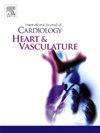经皮左心耳闭塞治疗癌症患者的短期和长期预后。
IF 2.5
Q2 CARDIAC & CARDIOVASCULAR SYSTEMS
引用次数: 0
摘要
简介和目的:经皮左心耳闭塞术(LAAO)是减轻不适合口服抗凝治疗的房颤(AF)患者出血和卒中风险的可行选择。由于癌症患者被排除在试验之外,其安全性和有效性尚不清楚。这项研究旨在比较癌症和非癌症患者之间的短期和长期LAAO结果。方法:对2010年4月至2023年12月期间连续361例LAAO患者进行回顾性单中心研究。短期结果包括围手术期并发症、30天住院再入院和死亡率。长期结果包括卒中、出血和死亡率的综合结果,并对每个组成部分分别进行评估。结果:该研究包括93例癌症患者(54%为活跃期,46%为缓解期)和268例非癌症患者。基线特征相似,包括缺血和出血风险概况(CHA2DS2-VASc: 4.5±1.4 vs 4.4±1.5;HAS-BLED: 3.3±0.9 vs. 3.2±0.9),既往卒中和总出血事件。短期结果显示围手术期并发症(7% vs. 6%)、30天再入院(2% vs. 3%)或30天死亡率(0% vs. 1.5%)无显著差异。32个月后,两组在综合终点(p = 0.067)、卒中(SHR 0.54;p = 0.25)或出血事件(SHR 1.36;p = 0.35)。LAAO在减少癌症和非癌症患者中风方面是有效的(p = 0.027和p = 0.006)。癌症患者的全因死亡率更高(p = 0.002),主要是由于癌症进展和感染。结论:LAAO手术在两种人群中安全有效。癌症患者的全因死亡率更高,两组之间的中风和出血结果没有差异。本文章由计算机程序翻译,如有差异,请以英文原文为准。
Short- and long-term outcomes of percutaneous left atrial appendage occlusion in cancer patients
Introduction and objectives
Percutaneous left atrial appendage occlusion (LAAO) is a viable option to mitigate bleeding and stroke risks in patients with atrial fibrillation (AF) who are not eligible for oral anticoagulation. Its safety and efficacy in cancer patients remain unclear due to their exclusion from trials. This study aimed to compare short- and long-term LAAO outcomes between cancer and non-cancer patients.
Methods
Retrospective single centre study of 361 consecutive patients who underwent LAAO between april-2010 and december-2023 were included. Short-term outcomes included periprocedural complications, 30-day hospital readmission and mortality. Long-term outcomes included the composite of stroke, bleeding, and mortality and each component assessed separately.
Results
The study included 93 cancer patients (54 % active, 46 % in remission) and 268 non-cancer patients. Baseline characteristics were similar, including ischemic and bleeding risk profiles (CHA2DS2-VASc: 4.5 ± 1.4 vs. 4.4 ± 1.5; HAS-BLED: 3.3 ± 0.9 vs. 3.2 ± 0.9), previous stroke and total bleeding events. Short-term outcomes showed no significant differences in periprocedural complications (7 % vs. 6 %), 30-day readmission (2 % vs. 3 %), or 30-day mortality (0 % vs. 1.5 %). Over 32 months, there was no significant difference regarding the composite endpoint (p = 0.067), stroke (SHR 0.54; p = 0.25) or bleeding events (SHR 1.36; p = 0.35). LAAO was effective in terms of stroke reduction in cancer and non-cancer patients (p = 0.027 and p = 0.006, respectively). All-cause mortality rates were higher in cancer patients (p = 0.002), mainly due to cancer progression and infections.
Conclusions
LAAO procedure was safe and effective in both populations. Cancer patients experienced higher rates of all-cause mortality, with no differences in stroke and bleeding outcomes between groups.
求助全文
通过发布文献求助,成功后即可免费获取论文全文。
去求助
来源期刊

IJC Heart and Vasculature
Medicine-Cardiology and Cardiovascular Medicine
CiteScore
4.90
自引率
10.30%
发文量
216
审稿时长
56 days
期刊介绍:
IJC Heart & Vasculature is an online-only, open-access journal dedicated to publishing original articles and reviews (also Editorials and Letters to the Editor) which report on structural and functional cardiovascular pathology, with an emphasis on imaging and disease pathophysiology. Articles must be authentic, educational, clinically relevant, and original in their content and scientific approach. IJC Heart & Vasculature requires the highest standards of scientific integrity in order to promote reliable, reproducible and verifiable research findings. All authors are advised to consult the Principles of Ethical Publishing in the International Journal of Cardiology before submitting a manuscript. Submission of a manuscript to this journal gives the publisher the right to publish that paper if it is accepted. Manuscripts may be edited to improve clarity and expression.
 求助内容:
求助内容: 应助结果提醒方式:
应助结果提醒方式:


